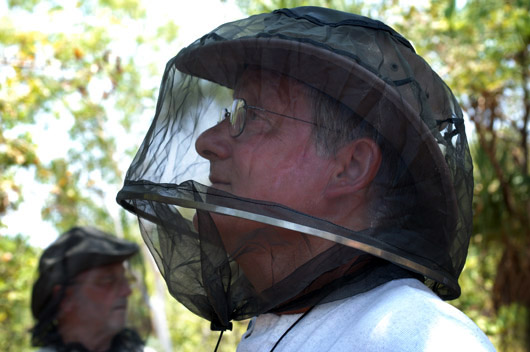A.bc
In Australia, sulle tracce di Chatwin 20 anni dopo Le Vie dei Canti
Palazzo delle Esposizioni, Roma
A.bc
In Australia, in Chatwin's footsteps 20 years after The Songlines Palazzo
Delle Esposizioni, Rome


Il
signore delle mosche, Ubirr. C’è un’estetica del bush,
fatta di stivaletti, pantaloncini corti, canottiere, camice a quadri,
cappelli Akubra da mandriano e ruvidi impermeabili Driza-Bone. La leggenda
degli impermeabiloni risale alle prime navi in rotta verso gli oceani
meridionali e a un marinaio scozzese, Edward Le Roy, che per sé
e i suoi compagni ricavò soprabiti a prova di maltempo cucendo
vecchie vele di cotone ingrassate con l’olio; nacque così
il “dry-as-a-bone” (secco-come-un-osso). Alcuni turisti si
calano nell’abito locale, altri optano per lo standard internazionale
da safari. Domina il kaki coloniale e le varie tonalità delle zone
semidesertiche, dagli ocra ai verdi. Qui, in più, c’è
la rete. Perché tra Red Centre e Top End c’è chi si
lamenta dei serpenti (molti e quasi tutti velenosissimi), chi dei canguri
(troppi, prosciugano le sorgenti), chi delle mosche. Numerosissime durante
i mesi più caldi e umidi. Fastidiosissime, sulla bocca, nel naso,
nelle orecchie, sugli occhi. Il rimedio: dalle semplici retine ad autentici
mini-scafandri. Timore del senso del ridicolo? Passa. Poi ci sono le mosche
virtuose. Qualche tempo fa i ricercatori della Università di Adelaide,
nel Sud Australia, hanno messo a punto il prototipo di una lente fotografica
che simula l’eccezionale apparato oculare delle mosche e permette
di avere un’immagine dettagliata anche nelle parti in ombra. La
ricerca è finanziata dall’aeronautica militare statunitense,
interessata ad applicare la nuova tecnologia alla sorveglianza aerea.
A Perth, invece, nell’Australia Occidentale, le larve di mosca aiutano
a risolvere gli omicidi: un entomologo ha infatti scoperto che il tipo
di larva ritrovata su un cadavere nel deserto era di una specie che vive
solo in città e che, perciò, il crimine era stato commesso
altrove. L’omicida è finito in carcere. Per il volo di una
mosca
The
Lord of the Flies, Ubirr. There is a fashion in the bush, made up of boots,
shorts, vests, shirts to paintings, herdsmen Akubra hats and rough Driza-Bone
raincoats. The legend of Driza-Bone dates back to the first ships heading
for the Southern oceans and to a Scottish sailor, Edward Le Roy, who made
waterproof overcoats for himself and his companions by sewing old cotton
sails greased with oil; this was the origin of the “dry-as-a-bone".
Some tourists choose local clothes, others opt for the standard international
safari style. Colonial khaki and the various shades of semidesert areas,from
green to ochre, predominate. Here, in addition, there is the net. Because
between Red Centre and Top End there are people who complain about snakes
(many and almost all very poisonous), about kangaroos (too many, they
dry up springs), or flies. Numerous during the warmer and wetter months
. Very annoying, around your mouth, nose, ears, eyes. The remedy: from
simple nets to an authentic mini-diving suit. Fear of a sense of the ridiculous?
It will pass. Then there are the virtuous flies. Some time ago, researchers
at the University of Adelaide, South Australia, developed the prototype
of a photographic lens that simulates the unique eye apparatus of flies
and allows a detailed image even in the shadow. The research is financed
by the U.S. Air Force, interested in applying new technology to aerial
surveillance. In Perth, Western Australia, fly larve help to solve murder
cases: an entomologist has discovered that the kind of larva found on
a corpse in the desert was of a species that lives only in the city and
that, therefore, the crime had been committed elsewhere. The murderer
ended up in prison. Because of the flight of a fly